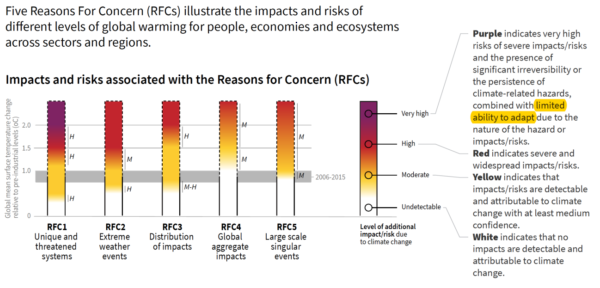Good news! Loss & damage in the IPCC Special Report on 1.5°C
Share

We are now in the IPCC’s sixth assessment cycle, and at every scoping meeting for the forthcoming special reports and the Sixth Assessment report, Small Island Developing States (SIDS) have been calling for the consideration of loss and damage. Now the first report of the cycle is out – the Special Report on 1.5°C. Where does this report put us in terms of reflecting the evidence base on loss and damage?
Let’s start with why scientific information on loss and damage is important for the SIDS. Previously the IPCC has provided an assessment of limits to adaptation, but this has not provided the level of detail needed to understand what losses will be experienced at different levels of warming, nor the coping strategies that may be required to address them. A growing literature base on what constitutes loss and damage merits a more comprehensive assessment by the IPCC.
The short story is that the IPCC has come a long way. For the first time, the concept of Loss and Damage, and its evidence base, are clearly reflected in the work of the IPCC. Chapter 5 contains a box dedicated to the topic, reflecting the rich and growing literature on the topic. Within this box, limits to adaptation are pointed out for various systems and regions, with the clear recognition of SIDS hitting hard adaptation limits already at 1.5°C, with substantially more losses and damages above this warming level. For more information, see the summary, put together by some of the authors who contributed to the box on Loss and Damage.
Some key messages on Loss and Damage have even made it to the Summary for Policymakers. This is noteworthy because the Summary for Policymakers is discussed – and agreed to – by state representatives line by line, and thus carries quite some political weight. The adopted summary clearly states that “there are limits to adaptation and adaptive capacity for some human and natural systems at global warming of 1.5°C, with associated losses”, which may seem like a relatively simple statement, but its inclusion in the Summary for Policymakers shows that the existence of adaptation limits at 1.5°C is a scientifically robust finding acknowledged by all governments. This is a first for Loss and Damage in the IPCC’s work.
Also in the Summary for Policymakers is an update of an iconic figure that has been included in IPCC reports since 2007: the burning embers diagram. This figure shows the severity of potential adverse impacts for different levels of warming, and also shows the point where limits to adaptation kick in (dark purple), providing a clear link to loss and damage.
It is pretty clear that 1.5°C is not a level of warming that we want to exceed. A key message from the update of this figure is that the risks are worse than we previously thought – in many cases the level of risk we once thought would occur at 2°C of warming or above could actually happen at lower warming levels.
The starkest example is that threatened ecosystems such as coral reefs hit adaptation limits already around 1.5°C. As research into these limits develops, the IPCC should continue to assess and update this figure.
The recognition and reflection of Loss and Damage by the IPCC in this special report sends an important signal. For one it sets a precedent for this kind of information to be reflected in forthcoming reports. In particular the special report on the oceans and cryosphere due in summer 2019, which will cover sea level rise, storm surges, glacial retreat, and coral reef impacts, will have a lot of relevant material on Loss and Damage to assess.
At the same time, it will hopefully trigger further research and publications, not only describing the problem but also proposing solutions. As pointed out in an earlier blog entry, the financial capacity of SIDS to cope with losses and damages is increasingly dwindling and traditional financial instruments will no longer apply. Novel solutions are needed. At the same time, a deeper understanding of limits to adaptation and adaptive capacities is needed in order to enable countries to address those limits where it is still possible.
Perhaps forthcoming reports will even venture into recording observed impacts and consequent losses as a key element of information. Notwithstanding the cultural contingency of what counts as losses, “simple” metrics such as lives lost, GDP losses and people displaced would seem like a good starting point, and could provide valuable input for the regular Global Stocktakes of progress under the Paris Agreement.
Vulnerable countries have made their needs for information on loss and damage clear and the Special Report on 1.5°C has shown that this information exists. With actual loss and damage increasing and action on loss and damage progressively being taken, we can count on more evidence being published. Let's hope the forthcoming IPCC reports will build on the latest report and reflect the information that is so much needed.













